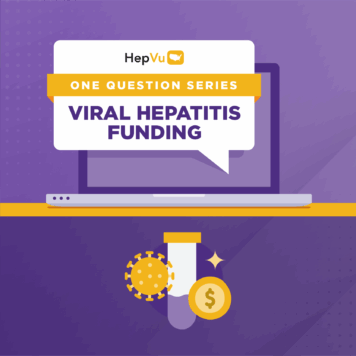Jim Macrae, MA, MPP, is the Associate Administrator of the Bureau of Primary Health Care (BPHC) in the Health Resources and Services Administration (HRSA) at the U.S. Department of Health and Human Services (HHS).
Q: As Associate Administrator of BPHC, you manage a $5.6 billion budget that supports nearly 1,400 health centers in all U.S. states, as well as the District of Columbia, Puerto Rico, the U.S. Virgin Islands, and the Pacific Basin. How are you supporting these health centers in their work to integrate viral hepatitis testing, vaccination, and treatment into primary care?
HRSA-funded health centers are uniquely positioned to assist with viral hepatitis efforts. Health centers provide care to nearly 30 million patients—that’s 1 out of every 11 people nationwide. They are community-based and patient-directed organizations that deliver comprehensive, culturally competent, and high-quality primary care services to the nation’s most socially vulnerable and underserved individuals and families, regardless of their ability to pay. Many people at risk for or living with viral hepatitis are members of these vulnerable populations and underserved communities. They may also be at risk for other illnesses or chronic conditions, including HIV and substance use disorder.
Health centers have the expertise to manage patients with multiple health care needs, and they follow a model of integrated care in which medical, dental, behavioral health, substance use disorder, and other services are provided in a coordinated way. By integrating viral hepatitis testing, vaccination, and treatment with other prevention, care, and treatment strategies, health centers are able to improve health outcomes, both for patients at risk of acquiring hepatitis and for those living with chronic infection.
BPHC also supports health centers by providing training and technical assistance on testing, vaccination, and treatment of viral hepatitis. For example, last year BPHC developed and delivered an Introduction to Hepatitis B (HBV): Testing and Best Practices webinar. This webinar discussed the identification of basic symptoms and the appropriate tests to use when diagnosing and treating patients with Hepatitis B, consistent with the U.S. Preventive Services Task Force (USPSTF) guidelines. For Hepatitis Awareness Month in May 2021, BPHC and Centers for Disease Control and Prevention (CDC) collaborated on a Getting Back to the Basics webinar that provided an overview of the updated Hepatitis C testing guidelines and recommendations. This webinar featured presentations on how clinicians are implementing the updated Hepatitis C testing recommendations in a public health setting.
Q: In 2019, HRSA reported that health centers had tested more than 900,000 people for Hepatitis B and over one million people for Hepatitis C. How did the COVID-19 pandemic impact hepatitis screening in 2020?
There’s no question COVID-19 significantly disrupted the delivery of primary care. Health centers faced a lot of challenges last year, ranging from stay-at-home orders to temporary clinic closures to lack of personal protective equipment (PPE). They also faced staffing challenges due to childcare issues and clinician burnout. The 2020 Uniform Data System (UDS) data will be released soon, and we anticipate that Hepatitis B and Hepatitis C testing rates at health centers will be lower because of the COVID-19 pandemic. But a preliminary analysis suggests that while health centers did see a reduction in the number of patients tested for hepatitis in 2020 compared with that of 2019, this reduction is proportional to the overall decrease in patients seen due to COVID-19.
Thankfully, despite the challenges, many health centers were quick to pivot from in-person to virtual visits, allowing for continuity of care. Now, in-person care and the total volume of patient visits are slowly returning to pre-pandemic levels. HRSA has been collecting weekly voluntary data from health centers via the Health Center COVID-19 Survey since April 2020. Recent data show that health centers are now conducting 20% of visits virtually, compared with 39% of visits this time last year. In addition, health centers are slowly ramping up their capacity to see more patients. They report that weekly visits, both in-person and virtual, are at 90% compared with their pre-COVID volume, whereas last summer they were reporting only being at 70% of their pre-COVID volume.
Q: How do the updated hepatitis screening guidelines from the USPSTF and the CDC affect testing in HRSA’s health centers and facilities?
HRSA-funded health centers are expected to follow the USPSTF guidelines for Hepatitis B and C testing and Hepatitis A and B vaccinations, and they’re expected to offer appropriate care and treatment for patients who test positive for these viruses.
The updated recommendations, which became effective in March 2020, will transform the way health centers implement testing. Most health centers have been testing only high-risk populations or conducting testing among people born between 1946 and 1964. However, the updated testing recommendations will have health centers screen all adult patients between the ages of 18 and 79. To support implementation, staff will need to incorporate viral hepatitis into routine visit discussions, including the questions staff pose to patients aged 18 to 79. Finally, providers will be encouraged to use “motivational interviewing” techniques and “teach-back” methods to help ensure that patients understand the information and increase patients’ engagement with their health care. Motivational interviewing is an evidence-based, patient-centered communication that is targeted towards changing behavior. It is designed so that patients feel seen, heard, supported, and empowered in their decision-making.
BPHC will provide health centers with technical assistance to help them follow these guidelines, adjust their workflows as needed, and increase the quality of viral hepatitis care they deliver.
Q: This January, HHS released the Viral Hepatitis National Strategic Plan: A Roadmap to Elimination 2021-2025. How are BPHC and its funded health centers working to make viral hepatitis services more accessible to medically underserved populations and regions that are disproportionately impacted and to achieve the plan’s goal to eliminate viral hepatitis in the U.S. by 2030?
Health centers use an integrated, interdisciplinary approach to provide comprehensive primary health care services. This places them in a strong position to help prevent and manage viral hepatitis among the nation’s most vulnerable populations. While there are many factors that can make it difficult for underserved populations to access viral hepatitis services, there are steps that health centers can take to improve access. For example, if possible, it’s helpful to keep all testing, treatment, and services in-house instead of referring the patient to a specialist. Keeping a patient’s care in one place — a place where they are already comfortable and have an established relationship with the provider and staff — can increase the chances that they receive the necessary treatment.
It’s also important to improve staff engagement. For example, health centers can increase their clinical and supporting staff’s awareness of cultural backgrounds and the respective needs of specific populations, which will help to lay the groundwork for stronger connections with patients and improved health care. And of course, it’s important to educate providers on the latest CDC viral hepatitis testing guidelines.
Health centers may use funds from a variety of HRSA awards to support viral hepatitis prevention and management activities, including the robust American Rescue Plan funding awarded earlier this year. American Rescue Plan funding can support an array of activities, such as hiring new providers and support staff (including care managers, community health workers, patient education and outreach staff, and transportation staff), providing training for staff, enhancing workflows, and expanding telehealth infrastructure.
Q: July 28 is World Hepatitis Day. What message do you have for the viral hepatitis community, including clinicians, advocates, and people living with viral hepatitis?
Let me begin by saying that BPHC is committed to supporting the Viral Hepatitis National Strategic Plan: A Roadmap to Elimination 2021-2025 and its plan to eliminate viral hepatitis in the U.S. by 2030. As we’ve discussed, because health centers deliver coordinated, comprehensive care and can manage patients with multiple health care needs, they are uniquely positioned to increase access to testing, vaccination, and treatment and to improve health outcomes for at-risk patients and patients with chronic infection.
BPHC will bolster existing efforts by continuing to encourage health centers to improve screening, vaccinations, and treatment for viral hepatitis and to incorporate viral hepatitis into routine visit discussions and screening tools. BPHC will also continue to provide training and technical assistance to ensure that health centers and their staff have the information, tools, and resources they need. Additionally, we will amplify HHS messaging related to hepatitis, such as sharing the Viral Hepatitis National Strategic Plan: A Roadmap to Elimination 2021-2025, all relevant recommendations from the Advisory Committee on Immunization Practices (ACIP), and other CDC updates and resources.



